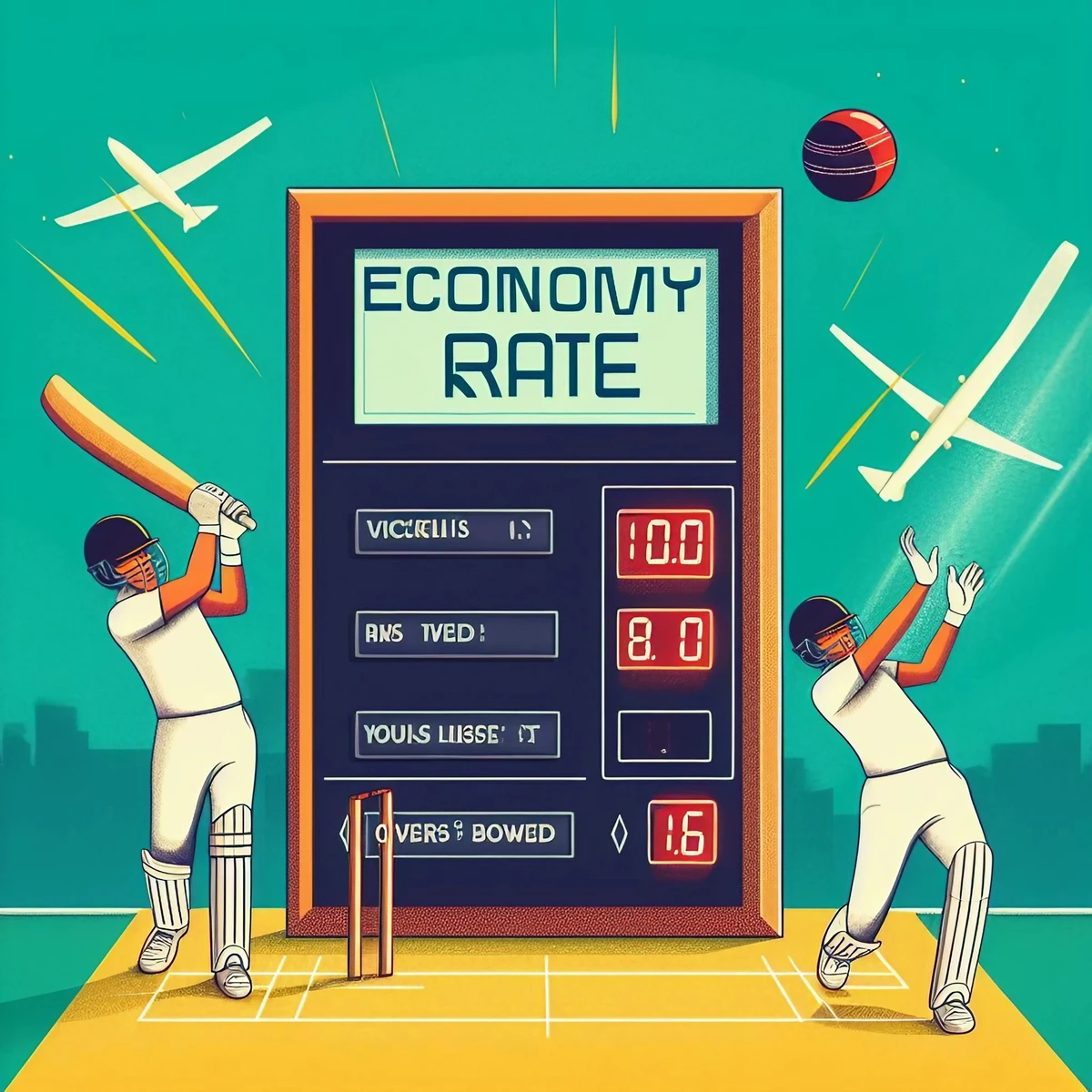Home » Cricket Calculators » Cricket Bowling Average Calculator
Bowling Average Calculator
Cricket Bowling Average Calculator
Bowling average gives crucial context on bowlers’ effectiveness versus economy in cricket. This metric quantifies a key factor – wickets taken per runs conceded.
200% Welcome Bonus | SPRIBE
200% Welcome Bonus | SPRIBE
- Fastest Indian Rupees Withdrawals
- Win 1000x Bet Amount!
- 300% Welcome Bonus up to ₹10,000
The calculation divides total runs given up by wickets taken. For instance, 150 runs conceded and 15 wickets means a bowling average of 150/15 = 10.
Bowling Average Calculator
Lower averages indicate greater bowling productivity. Factors like pitch conditions, opposition strengths and match situations influence averages. But over time, averages reveal bowling impact.
Bowling average helps selectors make informed choices for national and league squads. Coaches utilize averages to plan bowling attacks and assignments. Players aim to maintain low career averages to showcase skills.
By crystallizing wicket-taking consistency against runs leaked, bowling average provides an invaluable benchmark for performance analysis. It distills a bowler’s value to restricting opposition scoring and taking key wickets.
What is Bowling Average in Cricket?
Bowling average is a key statistic in cricket that measures a bowler’s effectiveness and consistency in taking wickets. It is calculated by dividing the total number of runs conceded by a bowler by the number of wickets taken.
For example, if a bowler has conceded 1500 runs but taken 50 wickets, their bowling average is 1500/50 = 30.
A lower bowling average indicates a bowler takes wickets more economically by conceding fewer runs per wicket. Top bowlers maintain career averages under 25 or even 20.
Comparing bowling averages helps evaluate bowlers’ relative skills. Examining averages over time shows highs and lows in performance.
Bowling average provides a snapshot of a bowler’s potency for taking key wickets and maintaining economical spells.
By encapsulating wicket-taking productivity versus runs given up, bowling average is a fundamental metric for assessing bowling performance in cricket. It highlights a core bowler skill – extracting wickets without leaking too many runs.
TL;DR
Hide- The bowling average is a crucial statistic in cricket that allows teams to assess a bowler’s effectiveness. It provides valuable insights into a bowler’s consistency and skill level, helping teams make informed decisions regarding team selection and strategy.
- To calculate the bowling average, the total number of runs conceded by the bowler is divided by the total number of wickets taken. This average represents the number of runs a bowler typically concedes per wicket. A lower bowling average indicates a more effective bowler.
- Analyzing bowling averages allows teams to identify trends and compare the performances of different bowlers. It helps teams understand which bowlers are performing well and contributing to the team’s success.
- Overall, the bowling average serves as a crucial tool for evaluating a bowler’s performance in the game of cricket. It helps teams make strategic decisions and assess a bowler’s impact on the game. As teams strive for success, the bowling average is an essential metric to consider.
The Basics of Bowling Average in Cricket
Understanding the concept of bowling average in cricket requires an understanding of how it is calculated (we also provide bowling average calculator).
The bowling average is a numerical calculation that measures a bowler’s performance in terms of taking wickets.
It is determined by dividing the total number of runs conceded by the bowler by the number of wickets taken. This calculation gives us an average number of runs conceded per wicket. A lower bowling average indicates a more successful bowler.
Analyzing a bowler’s performance requires interpreting statistics, and the bowling average is a crucial metric in this regard. It helps evaluate a bowler’s consistency and effectiveness.
A lower bowling average suggests that the bowler is more likely to take wickets and restrict the opposition’s scoring.
On the other hand, a higher bowling average indicates a less effective bowler who may struggle to make breakthroughs.
Understanding the calculation and interpretation of bowling average allows cricket enthusiasts to accurately assess and compare the performances of different bowlers.
It provides valuable insights into a bowler’s impact on the game and aids in strategic decision-making by captains and coaches.
Understanding the Numerical Calculation
The calculation of a bowler’s bowling average in cricket is a simple yet significant statistical measure that allows for the analysis and comparison of different players’ performances.
Here are three key points to help you understand this calculation:
- Runs Conceded: The bowler’s total number of runs conceded refers to the runs scored by the batsmen off the bowler’s deliveries. This includes runs scored off the bat as well as any extras, such as wides or no balls, conceded by the bowler.
- Wickets Taken: The number of wickets taken by a bowler represents the number of times they have successfully dismissed a batsman. Wickets can be taken through various methods, such as bowling the batsman out, catching the batsman, or achieving a run-out.
- Calculation of Bowling Average: To calculate the bowling average, divide the total number of runs conceded by the bowler by the number of wickets taken. This provides an average number of runs conceded per wicket taken, which indicates the bowler’s effectiveness in preventing runs and taking wickets.
Understanding the numerical calculation of bowling average is crucial in assessing a bowler’s performance in cricket. It offers valuable insights into their bowling skills and allows for meaningful comparisons with other players.
Now, let’s explore the importance of bowling average in cricket.
Importance of Bowling Average in Cricket
The bowling average in cricket is a crucial measure of a bowler’s performance. It provides valuable insights into their effectiveness and impact on the game.
The calculation is simple: divide the total number of runs conceded by the bowler by the number of wickets taken. A lower bowling average indicates that the bowler is successful in taking wickets while conceding fewer runs, which makes them a valuable asset to the team.
The importance of the bowling average can be seen in its impact on team strategy. Bowlers with low averages are trusted with more overs and given more responsibility in crucial situations.
They are often considered the go-to bowlers for taking wickets and putting pressure on the opposition. On the other hand, bowlers with high averages may be assigned different roles, such as containing the runs or providing support to the strike bowlers.
To illustrate the significance of the bowling average, let’s consider the following example:
| Bowler | Matches | Wickets | Runs Conceded | Bowling Average |
|---|---|---|---|---|
| Bowler A | 20 | 50 | 2000 | 40.00 |
| Bowler B | 20 | 60 | 1800 | 30.00 |
| Bowler C | 20 | 40 | 2500 | 62.50 |
In this example, Bowler B has the lowest bowling average, indicating their superior performance compared to Bowler A and Bowler C.
This data can help the team management make informed decisions regarding team selection and bowling strategies.
Factors Affecting Bowling Average
There are several factors that can have a significant impact on a bowler’s average in cricket. One of these factors is skill level. Bowlers with higher skill levels tend to take more wickets and have lower averages.
Another important factor is match conditions. Pitch conditions, weather, and the quality of the opposition can all affect a bowler’s performance and, consequently, their average.
The skill level of a bowler plays a crucial role in determining their average. Bowlers who possess advanced skills are more likely to outperform their opponents and take more wickets.
This results in a lower average, as they are able to dismiss batsmen more frequently. On the other hand, bowlers with lower skill levels may struggle to consistently take wickets, leading to a higher average.
Match conditions also play a significant role in a bowler’s average. The condition of the pitch can greatly impact a bowler’s ability to generate movement or extract bounce.
- Net Run Rate Calculator: How to Calculate Run Rate in Cricket
- Cricket Batting Average Calculator
- Cricket Batting Strike Rate Calculator
- Cricket Bowling Average Calculator
- Cricket Bowling Strike Rate Calculator
- Cricket Economy Rate (Econ) Calculator
- Cricket Follow On Calculator
- Cricket Runs per Over Calculator
Additionally, weather conditions such as wind or rain can affect a bowler’s grip on the ball and their ability to control it effectively.
Finally, the quality of the opposition team can have an influence on a bowler’s average. Facing skilled and experienced batsmen can make it more challenging for a bowler to take wickets and lower their average.
Skill Level Impact
Improving a bowler’s skill level has a significant impact on their average in cricket. Skill level encompasses various factors that directly influence a bowler’s consistency and performance.
Let’s explore three key factors that contribute to the impact of skill level on a bowler’s average:
- Technique: A bowler with a polished technique possesses better control over line, length, and swing. This enables them to consistently hit the desired areas, making it challenging for batsmen to score runs.
- Variation: The ability to deliver different types of balls, such as yorkers, bouncers, and slower balls, adds unpredictability to a bowler’s arsenal. This makes it difficult for batsmen to anticipate and score freely.
- Fitness: Maintaining a high level of fitness allows a bowler to perform consistently throughout a match or series. Good fitness levels enable them to consistently bowl with pace and accuracy, increasing their chances of taking wickets and limiting the opposition’s scoring rate.
Match Conditions Influence
The performance of a bowler in cricket is significantly influenced by match conditions. Factors such as the condition of the pitch, weather conditions, and the format of the match all play a role in determining a bowler’s average.
The condition of the pitch is crucial in determining a bowler’s average. A dry and crumbling pitch tends to favor spinners, while a green and moist pitch assists seamers.
Additionally, weather conditions like heavy rainfall or extreme heat can affect the movement of the ball and overall playing conditions, which in turn impact a bowler’s average.
Furthermore, the format of the match also affects a bowler’s average. In limited-overs cricket, where the number of overs is restricted, bowlers often employ different strategies compared to Test matches, which can influence their average.
To better understand the influence of match conditions on a bowler’s average, consider the following factors:
- Pitch Condition: Determines the type of bowler that is favored.
- Weather Condition: Affects the movement of the ball.
- Match Format: Influences the bowler’s strategy.
How to Calculate Bowling Average
Calculating a bowler’s average in cricket is a straightforward process that involves dividing the total number of runs conceded by the total number of wickets taken during a specified period.
The bowling average is a significant statistical measure that reflects a bowler’s effectiveness in taking wickets while minimizing runs.
Here are three commonly used methods for calculating bowling average:
- Overall Bowling Average: This method calculates the average over a bowler’s entire career. It provides a comprehensive understanding of the bowler’s overall performance.
- Series or Tournament Bowling Average: This method calculates the average for a specific series or tournament. It helps assess a bowler’s performance in a particular event and compare it to their overall average.
- Recent Bowling Average: This method calculates the average over a recent period, such as the last few matches or the current season. It provides an up-to-date measure of a bowler’s form and performance.
The accuracy of a bowler’s average can be influenced by various factors, including pitch conditions, weather, quality of opposition, and the bowler’s role in the team. Considering these factors is essential when interpreting bowling average statistics.
In the next section, we will explore the interpretation of bowling average statistics and discuss their significance in evaluating a bowler’s performance.
Interpreting Bowling Average Statistics
Bowling average statistics offer valuable insights into a bowler’s performance by measuring their effectiveness in taking wickets and minimizing runs conceded. Interpreting these stats can help evaluate a player’s consistency and overall impact on the game.
When analyzing bowling average statistics, it’s important to consider the number of matches played by the bowler. A higher average may not always indicate poor performance if the bowler has consistently faced strong opponents. Similarly, a lower average against weaker teams may not necessarily reflect exceptional skills.
It’s also crucial to examine the trend in the bowling average over time. A consistent decrease in the average indicates improvement and growing effectiveness as a bowler. Conversely, a fluctuating or increasing average may suggest inconsistency or a decline in performance.
Furthermore, comparing a bowler’s average with the team average can provide insights into their contribution. If a bowler consistently maintains an average lower than the team average, it indicates their ability to outperform their peers.
Interpreting bowling average statistics requires a comprehensive analysis of various factors, such as the quality of opposition, playing conditions, and the bowler’s role within the team. By considering these factors, one can gain a deeper understanding of a bowler’s performance, consistency, and impact on the game.
Comparing Bowling Averages of Different Bowlers
When comparing the bowling averages of different bowlers, it’s important to analyze their performances thoroughly.
By looking at the average runs conceded per wicket, we can identify the top-performing bowlers who consistently excel on the field.
This analysis enables teams and selectors to make well-informed decisions about player selection and strategic planning, ultimately leading to enhanced performance.
Analyzing Bowling Performances
One way to compare the bowling performance of different players is by looking at their respective bowling averages.
Bowling average analysis is a valuable tool in cricket that allows teams and coaches to assess the effectiveness of individual bowlers.
By comparing bowling averages, teams can identify the most consistent and successful bowlers in their lineup.
Here are three important factors to consider when analyzing bowling performances:
- Consistency: A bowler with a lower bowling average is likely to be more consistent in taking wickets. Consistency is crucial in maintaining pressure on the opposition and contributing to the team’s success.
- Economy Rate: Alongside bowling averages, the economy rate is also important in analyzing bowling performances. A bowler with a low economy rate generally restricts the flow of runs, making it harder for the batsmen to score freely.
- Strike Rate: The strike rate indicates how many balls a bowler takes to dismiss a batsman. A lower strike rate suggests a bowler’s ability to take wickets more frequently, making them a valuable asset to the team.
Identifying Top Bowlers
Identifying the top bowlers in cricket involves comparing the bowling averages of different players. Bowling average is a key statistical measure that shows how effective a bowler is in terms of runs conceded per wicket taken.
It provides valuable insights into a bowler’s consistency, skill, and overall impact on the game.
A low bowling average indicates a bowler’s ability to take wickets while giving away fewer runs, making them a valuable asset to their team.
By considering bowling averages, teams can strategize their gameplay accordingly. These bowlers can be relied upon to break partnerships, control the opposition’s scoring rate, and ultimately influence the outcome of the match.
Therefore, understanding the importance of bowling average and its impact on team strategy is vital in recognizing the top bowlers in cricket.
Analyzing Bowling Average Trends
When examining the trends in bowling averages in cricket, it’s important to consider the various factors that impact a bowler’s overall performance.
By analyzing techniques and historical data, we can gain valuable insights into the patterns that emerge over time.
Here are three key factors to consider when analyzing bowling average trends:
- Bowler’s Form: The current form of a bowler plays a significant role in determining their bowling average. A bowler in good form is more likely to take wickets and limit the opposition’s scoring, resulting in a lower average. Conversely, a bowler experiencing a rough patch may struggle to perform consistently, leading to a higher average.
- Strength of the Opposition: The quality of the opposition team also affects a bowler’s average. Bowling against stronger teams with skilled batsmen can make it challenging for a bowler to take wickets and maintain a low average. On the other hand, bowling against weaker teams can inflate a bowler’s average as they may find it easier to dismiss batsmen.
- Pitch and Ground Conditions: The nature of the pitch and ground conditions can significantly impact a bowler’s average. Certain bowlers may excel on specific pitches, such as spinners on turning tracks or fast bowlers on bouncy surfaces. Analyzing how a bowler’s average varies based on different pitch and ground conditions can provide valuable insights into their performance.
By considering these factors and analyzing historical data, we can gain a deeper understanding of bowling average trends and make more informed assessments of bowlers’ performances.
Understanding these trends can help cricket enthusiasts appreciate the complexities of the game and identify emerging talents.
In the next section, we will address common misconceptions about bowling averages.
Common Misconceptions About Bowling Average
The misconceptions surrounding bowling average in cricket often arise from a lack of understanding of how it is calculated and its true significance in assessing a bowler’s performance.
Many people mistakenly believe that a lower bowling average always indicates better performance, but this is not necessarily true.
Bowling average is actually a measure of a bowler’s effectiveness in taking wickets, rather than simply the number of runs conceded.
To calculate bowling average, you divide the total number of runs conceded by the total number of wickets taken.
Another misconception is that a single match can significantly impact a bowler’s overall average. While an exceptional or disastrous performance can have some impact, bowling average is a cumulative statistic that considers a bowler’s performance across multiple matches. This approach provides a more accurate representation of their overall ability.
It is also important to understand the statistical significance of bowling average. A difference of a few decimal points may not be significant when evaluating a bowler’s performance.
It is crucial to consider other factors such as pitch conditions, the quality of the opposition, and the overall team performance.
Utilizing Bowling Average in Team Selection and Strategy
Using bowling average in team selection and strategy is essential for maximizing performance on the field.
The bowling average provides valuable insights into the impact of individual bowlers, helping selectors identify the most effective players for the team.
By analyzing bowling averages, teams can gain a better understanding of their strengths and weaknesses, allowing them to devise game plans that exploit opponents’ vulnerabilities.
This strategic approach ensures that teams have a well-rounded lineup that can compete at a high level.
Selection Impact: Bowling Average
The bowling average is a critical factor in the selection and strategic decision-making process for cricket teams. It is a key statistic that measures a bowler’s performance and effectiveness.
Let’s explore three ways in which a bowler’s bowling average impacts team selection and team performance:
- Evaluating Bowlers: The bowling average helps selectors and coaches assess the consistency and reliability of bowlers. A lower average indicates that a bowler takes wickets more frequently, making them a valuable asset to the team.
- Comparing Performance: Bowling averages allow for easy comparison between different bowlers. Selectors can use these averages to identify the most effective bowlers and make informed decisions about team composition.
- Team Strategy: Bowling averages are used in strategic planning by analyzing the strengths and weaknesses of opposing batsmen. This information helps teams determine which bowlers are best suited to exploit specific weaknesses and formulate effective game plans.
Understanding the impact of bowling average on selection is crucial for teams aiming to optimize their performance on the field. In the next section, we will explore how bowling average is utilized in strategy planning.
Strategy Planning: Bowling Average
When incorporating bowling average into team selection and strategy planning, teams can effectively evaluate the performance and suitability of their bowlers.
By analyzing bowling averages, teams can identify their most consistent and successful bowlers, which can inform their selection for crucial matches.
Additionally, understanding the bowling averages of opposition players can help teams develop effective strategies to counter their strengths and exploit their weaknesses.
To improve bowling averages, teams can employ various strategies. This may include focusing on specific bowling techniques, such as swing or spin, depending on the strengths of the bowlers.
Teams can also work on developing mental resilience and maintaining a positive mindset, as the psychology of maintaining a good bowling average plays a significant role in performance.
By incorporating these strategies and understanding the psychology behind bowling averages, teams can greatly enhance their ability to plan their strategy and achieve success on the cricket field.
Strategies for improving bowling average:
- Focus on specific bowling techniques
- Analyze opposition players’ averages
- Regular practice and skill development
- Analyze and learn from previous performances
- Seek guidance from experienced coaches
The psychology of maintaining a good bowling average:
- Develop mental resilience
- Maintain a positive mindset
- Stay confident and focused
- Manage pressure effectively
- Set realistic goals and work towards them
‘A consistent bowling average is crucial for a team’s success on the cricket field.’
Balancing Team Strengths: Bowling Average
Balancing Team Strengths: Utilizing Bowling Average
Teams can effectively balance their strengths by using the bowling average in team selection and strategy. The bowling average is a crucial factor in determining a player’s performance and contribution to the team.
By analyzing the bowling averages of different players, teams can make informed decisions regarding team composition and strategy.
Here are three ways teams can use bowling average to balance their strengths:
- Identifying consistent performers: Teams can evaluate the bowling averages of players to identify those who consistently perform well. These players can be relied upon to maintain a high level of performance and contribute to the team’s success.
- Assessing the effectiveness of different bowling styles: Bowling averages can help teams analyze the effectiveness of different bowling styles. Teams can select a combination of bowlers with varying averages to create a well-rounded bowling attack that can exploit the weaknesses of the opposition.
- Identifying potential weaknesses: By assessing the bowling averages, teams can identify potential weaknesses in their bowling lineup. This allows them to address these weaknesses by selecting players with better averages or by implementing strategic changes to maximize the team’s performance.
Conclusion
The bowling average is an important statistic in cricket that helps assess a bowler’s effectiveness. It provides valuable insights into a bowler’s consistency and skill level, enabling teams to make informed decisions about team selection and strategy.
By understanding how the bowling average is calculated and the factors that impact it, teams can analyze trends and compare the performances of different bowlers.
Overall, the bowling average serves as a crucial tool for evaluating a bowler’s performance in the game of cricket.
Frequently Asked Questions
How do you calculate average in bowling?
Bowling average is calculated by dividing the total number of runs a bowler has conceded by the number of wickets they have taken. For example, if a bowler gives up 250 runs in total but takes 20 wickets, their bowling average is 250/20 = 12.5. The lower the bowling average, the better the bowler’s performance.
Up to 75% Reload Bonus on Aviator
Up to 75% Reload Bonus on Aviator
- Fastest Indian Rupees Withdrawals
- The Biggest Bonuses in India
- 450% Bonus up to ₹1,000,000
What is called bowling average?
In cricket, a bowler’s bowling average refers to the average number of runs they concede per wicket taken. It measures how effectively a bowler can take wickets while minimizing runs given up. Bowling average is a key metric used to evaluate and compare bowlers’ skills and productivity in cricket. A lower career bowling average indicates a more economic wicket-taking bowler.
Other Cricket Calculators
Latest Cricket Posts
Claim 200% Welcome Bonus
For a limited time, every new member can claim 200% Welcome Bonus upon registration up to ₹15,000. Read to bet?













